
The Arils of the Podocarpus are ripening. Photo by Green Deane

Wild Grapes are coming into season a little early this year. This single-tendril species tends to be high in acid. Photo by Green Deane
April is a target month for many ripening edibles locally. July seems to be the runner up, this year. During foraging classes in coastal regions we have found ripe tallow plums and grapes. The latter are usually ripe in September and tallow plums throughout the fall. We’ve also found chanterelles but they are more dependent on seasonal rain. Also some wild plums are still producing, getting ripe and falling of the trees. Podocarpus arils and gopher apples are ripening and poised for next month are saw palmetto berries. Sea Grapes are usually in September. They are protected, not because they are rare, but the species helps to hold dunes in place.
As I had an excess of tallow plums locally, I tried dehydrating them and was quite unsuccessful. They took an excessive amount of time to dry, and rotted easily. I could not find any preservation information from Ethiopia or Brazil where the fruit are very popular. This did afford me an opportunity to taste the dried seeds, which have been eaten sparingly as they are a laxative and used as a spice. Their flavor was unremarkable and would be suitable for plain food if they weren’t diarrhea inducing. There is nothing to recommend the seeds as a spice.
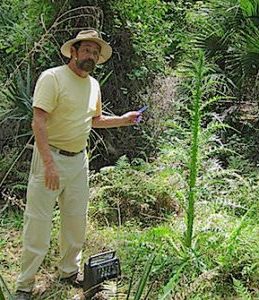
Foraging classes are held rain, shine, hot or cold. Photo by Nermina Krenata
Foraging Classes: The weather may or may not cooperate this weekend. Saturday’s class in Palm Harbor is probably not in doubt. Sunday’s class in Sarasota depends on the amount of rain. Light showers is fine, hurricane downpour is not. Rain doesn’t bother me but it can dissuade students.
Saturday, August 3rd John Chestnut County Park: 2200 East Lake Road, Palm Harbor, FL 34685. Meet at the trail head of the Peggy Park Nature Walk, pavilion 1 parking lot, 9 a.m. to noon.
Sunday August 4th, Red Bug Slough 5200 S. Beneva Road, Sarasota. 9 a.m. to noon, meet at the bathrooms. Tropical storm Debby will probably force this class to be cancelled.
Saturday August 10th, Lori Wilson Park, 1500 N. Atlantic Avenue, Cocoa Beach Fl, meet at the middle bathrooms by the large parking lot. 9 a..m.
Sunday August 11th, Dreher Park, 1200 Southern Blvd., West Palm Beach, 33405. 9 a.m. to noon. Meet just north of the science center.
For more information on these classes, to prepay or sign up go here. The cost is $30 per adult (the class is usually three hours long and examines five-dozen or so species.) If cost is a hardship email me at: GreenDeane@gmail.com.
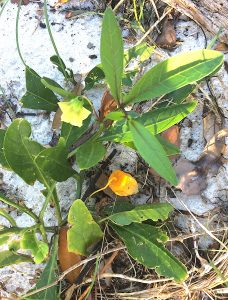
As the Ground Cherry ripens the husk turns golden. Photo by Green Deane
Rummaging about a mowed river bank we recently found Coastal Ground Cherries, Physalis angustifolia. Their husks were gold to a tan, dry and papery. Inside the fruit was deep yellow to gold, tangy in taste. Ground cherries ripen from green to gold, getting sweeter and tangier as they go along. But they can often have a bitter aftertaste either from being under ripe or some species just retain some bitterness. A little aftertaste of bitterness is okay but the best is when there is none. Thus one always tastes a ripe ground cherry then you wait a minute or so for any bitterness to appear. While locally Ground Cherries can fruit nearly all year, they do produce a spring and fall crop. In cooler climes — most of North America — they just have one season ripening in late summer and fall. Here our fall crop tends to be better than our spring one. Spring ground cherries can rot on the plant or get damaged by insects and that is also when I tend to find more bitter ones. But this time of year brings out the best in ground cherries. One can find whole, undamaged, very ripe Ground Cherries in significant numbers. You can make a pie out of them if you can manage to get some home uneaten. Incidentally there is a second local ground cherry that resembles the Coastal Ground Cherry. It’s Physalis walteri, also known as Starry-Hair Ground Cherry and Sand Cherry. It has star-shaped hairs on the lower edges of the leaf which are visible with a hand lens. Still has edible berries, however as does P. angulata, and other common Ground Cherry. Some people like to grow P. angulata in their garden. To read more about Ground Cherries go here.
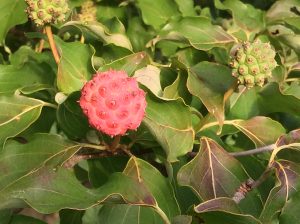
Ripe and unripe Kousa Dogwood fruit. Photo by Green Deane
In the backwoods of Maine where I grew up Dogwoods were small. Perhaps the weather and the species conspired to make them inconspicuous. They did not prepare me for more flamboyant Dogwoods including Kousa. A popular ornamental and escapee, Kousa Dogwood does have edible fruit. Whether you will like it or not is a different debate. When I was in North Carolina studying mushrooms at an agricultural center I noticed the landscaping around the main center was quite coiffured. But next to a lower parking lot where the forest met the pavement was a Kousa Dogwood happily invading the harrow agricultural ground. They were not originally planted for their fruit but rather their attractive blossoms. By the way, one of the ways to identify a Dogwood is to carefully tear a leaf apart across the veins. A latex in them will form threads and hold the two separated parts of the leaf together on white webs. To read more about the Kousa Dogwood go here.
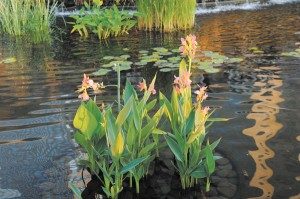
Canna can grow in a garden or a pond.
When it comes to plants you can see something for a long time but not see it. That was my experience with Canna. In the late 80’s a friend of mine had Canna planted along her house. As she was from Taiwan I presumed — like most of the plants around her home — they were native to Asia. As it turned out I was just one in a very long line of people thinking this native of the Americas was actually Asian. I didn’t make the connection to local Canna because the two species have different blossoms, one skinny and red, the other fat and yellow. But then one day while fishing along the St. Johns River east of Sanford I saw a large stand of “native” Canna and investigated. There are several edible parts to the Canna including the roots. The hard seeds, however, have been used as a substitute for buckshot… they are that hard. You can read more about this peripatetic beauty here.

Green Deane Forum
Tired of Facebook and want to identify a plant? The Green Dean Forum is up and running again. Have you come to dislike Facebook, then join us on the forum. Perhaps you’re looking for a foraging reference? You might have a UFO, an Unidentified Flowering Object, you want identified. On the Green Deane Forum we — including Green Deane and others from around the world — chat about foraging all year. And it’s not just about warm-weather plants or just North American flora. Many nations share common weeds so there’s a lot to talk. There’s also more than weeds. The reference section has information for foraging around the world. There are also articles on food preservation, and forgotten skills from

You get the USB, not the key.
172-video USB would be a good end of spring present and is now $99. My nine-DVD set of 135 videos has been phased out. The USB videos are the same videos I have on You Tube. Some people like to have their own copy. Most of the 172 USB videos have to be copied to your computer to play. If you want to order the USB go to the DVD/USB order button on the top right of this page. That will take you to an order form.
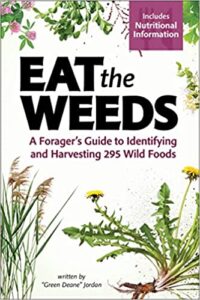
Now in second printing.
EAT THE WEEDS, the book, 274 plants, 367 pages, index, nutrition charts and color photos. It’s available in many locations including Amazon. Most of the entries include a nutritional profile. It can also be ordered through AdventureKeen Publishing.
This is weekly newsletter #607. If you want to subscribe to this free newsletter you can find the sign-up form in the menu at the top of the page.
To donate to the Green Deane Newsletter click here.

